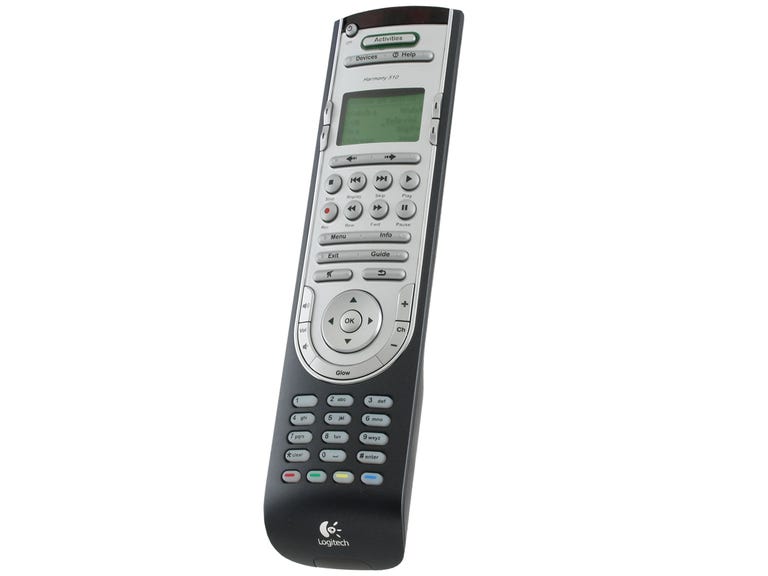 Why You Can Trust CNET
Why You Can Trust CNET Logitech Harmony 510 review: Logitech Harmony 510
Logitech Harmony 510
The Logitech Harmony 510 is the replacement for the Harmony 520, which is being discontinued. Except for a slightly different color scheme (silver on black instead of black on silver) and the addition of four color-coded buttons below the keypad, it's essentially the identical unit. The catch: Logitech cut the number of devices the 510 can control to just 5 (versus 12 for the 520). Thankfully, two other Harmony models--the Logitech Harmony 550 and the Logitech Harmony Advanced Universal Remote for Xbox 360 (AURX360)--remain available in Logitech's line. All four models are almost identical, but the 550 and AURX360 both have more buttons and control more devices than the 510--despite being available for a nearly identical sub-$100 street price. And that's pretty much the bottom line here: either one of those would be a better choice than the 510. (If you've got a bigger budget, the Harmony 720 or, ideally, the Harmony One are even better choices.)
The Good
The Bad
The Bottom Line
With that caveat in place: if you're still interested in the 510, read on.
The Logitech Harmony 510 crams a good number of buttons onto its modest frame, including a complete numeric keypad, a four-way directional pad, and full playback transport controls. The functional highlight of the 510 is the backlit LCD display. Flanked by four programmable keys that you can label differently on separate pages, it allows the Harmony to emulate even the most esoteric buttons as well as engage activities and macros. For the most part, the overall button layout is a pleasure to use, but we lamented the somewhat mushy rubber buttons and felt those on the numeric keypad were a bit too tiny and grouped too closely together, which sometimes caused us to misdial our channel changes.
The Harmony 510 uses four AAA batteries. We would've liked to see a recharger dock, such as the one found on the upscale Logitech Harmony models, but that's probably too much to ask from this entry-level model. Instead, you'll probably want to invest in a set of third-party rechargeable nickel-metal-hydride batteries.
As with all Harmony remotes, you add your devices and set up Activities using a computer-based interface (the remote is both Windows- and Mac-compatible). All Harmony remotes boast compatibility with more than 100,000 devices, and when we fired up the software and scrolled through the company list, we didn't see any reason to argue that bullet point. The scope can be a bit daunting for beginners, since there are a few dozen component types listed, such as TV, AV receiver, and DVD player, and hundreds of manufacturers within each one of those. Thankfully, the software is pretty forgiving, and as long as you have the company name and model number, it should be able to cull the commands for your product.
On the off chance that your device isn't yet in Logitech's database, it will try to find a close match (a similar product from the same manufacturer). Otherwise, you'll need to "teach" the Harmony commands from your existing remote (point the old remote at the Logitech's IR sensor, and follow the on-screen instructions). If you have a complicated setup, you might end up calling Logitech's customer service department for advice. However, most tech-savvy users will probably find it to be a pretty straightforward setup. Also, Logitech offers regular updates for both the remote's firmware and its PC-based software, so everything's generally up-to-date and relatively bug-free.
All told, we tested several components--TVs, AV receivers, DVD players, video game consoles, cable boxes, and home-stereo systems--and we couldn't find a remote-enabled product that was not listed or would not work once we uploaded the profile to the remote. Again, the big drawback here is the 5-device limit. If you've already got a quintet of gear--say, a TV, DVR, DVD recorder, Xbox 360, and Apple TV--you're out of luck if you want to add a Blu-ray player (or anything else) to the mix.
Along with the ability to control devices individually, the remote includes the Activities function that we liked so much in previous Logitech Harmony remotes. In essence, it allows the Harmony 510 to control different components simultaneously, and it works more intuitively than a standard device-centered remote. For example, you can program a Watch DVD activity that turns on your TV, AV receiver, DVD player, and speaker system; sets them all to the correct channels or inputs; and even starts playing the DVD. While the movie is playing, the controls you designate will punch through to the appropriate device: the DVD controls and the numerical keypad to control the DVD, the volume up/down buttons to control the speakers, and the power button to turn the whole thing off in one fell swoop. With a little care, we were able to get all of the important functions incorporated into the activities that we programmed; for those that we missed, we simply toggled back to the Component Control mode.
If something goes awry--say, the DVD player didn't power up--just hit the Help button, and the remote will take you through the activity step-by-step, and usually identify the problem. If a specific problem persists, you'll probably want to aim the remote a bit more specifically, or add in some delays to the various control sequences (when programming it with the software).
As far as PC-programmable universal remotes go, the Logitech Harmony 510 would've been a compelling universal remote--if not for the existence of the two nearly identical doppelgangers. Skip the 510, and go for the 550 (or, for Xbox 360 owners, the Xbox remote) instead. Either one delivers everything that the 510 does at a nearly identical price, but with the ability to control more devices.
Editors' Note: This review is based on the Logitech Harmony 550 review originally written by former Assistant Editor David Rudden.


